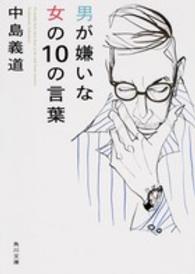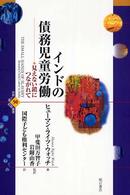- ホーム
- > 洋書
- > 英文書
- > Computer / General
Full Description
Climate change, rapid urbanisation, pandemics, as well as innovations in technologies such as blockchain, AI and IoT are all impacting urban space. One response to such changes has been to make cities ecologically sustainable and 'smart'. The 'eco smart city' for instance uses networked sensing, cloud and mobile computing to optimise, control, and regulate urban processes and resources. From real-time bus information to autonomous electric vehicles, smart parking, and smart street lighting, such initiatives are often presented as a social and environmental good.
Critics, however, increasingly argue that technologically driven, and efficiency-led approaches are too simplistic to deal with the complexities of urban life. Sustainability in the smart city is predominantly performed in limited ways that leave little room for participation and citizen agency despite government efforts to integrate innovative technologies in more equitable ways. More importantly, there is a growing awareness that a human-centred notion of cities, in which urban space is designed for, and inhabited by, humans only, is no longer tenable. Within the age of the Anthropocene - a term used to refer to a new geological era in which human activity is transforming Earth systems, accelerating climate change and causing mass extinctions - scholars and practitioners are working generatively by acknowledging the entanglements between human and non-human others (including plants, animals, insects, as well as soil, water, and sensors and their data) in urban life.
In Designing More-than-Human Smart Cities, renowned researchers and practitioners from urban planning, architecture, environmental humanities, geography, design, arts, and computing critically explore smart cities beyond a human-centred approach. They respond to the complex interrelations between human and non-human others in urban space. Through theory, policy and practice (past and present), and thinking speculatively about how smart cities may evolve in the future, the book makes a timely contribution to lively, contemporary scientific and political debates on genuinely sustainable smart cities.
Contents
Carl DiSalvo: Prologue
Sara Heitlinger, Rachel Clarke and Marcus Foth: Editorial Introduction
1: Donna Houston, Jessica McLean, and Natalie Osborne: Infrastructural Frictions: Care, Shadows and Ruins in Multispecies Smart Cities
2: Owain Jones: From 'Smart City' to Wise City? Thinking with Ecology, Water, and Hydrocitizenship
3: Yoko Akama: Reciprocities of Decay, Destruction, and Designing
4: Manuela Taboada and Jane Turner: Crossing Abyssal Lines: Telling Stories to Understand Decolonial Perspectives for More-Than-Human Futures
5: Alexander Holland and Stanislav Roudavski: Participatory Design for Multispecies Cohabitation: By Trees, for Birds, with Humans
6: Bill Gaver, Andy Boucher, Dean Brown, Naho Matsuda, Liliana Ovalle, Andy Sheen, and Mike Vanis: Exploring More-than-Human Smart Cities: The Emergent Logic of a Design Workbook
7: Jonathan Metzger and Jean Hillier: Bugs in the Smart City: A Proposal for Going Upstream in Human-Mosquito Co-Becoming
8: Annika Wolff, Allan Owens, and Lasse Kantola: Designing Data Dramas to Build Empathy to Nature Through Collective Acts
9: Clara Mancini, Daniel Metcalfe, and Orit Hirsch-Matsioulas: Justice by Design: The Case for Equitable and Inclusive Smart Cities for Animal Dwellers
10: Mennatullah Hendawy, Shaimaa Lazem, and Rachel Clarke: De-Centring in More-than-Human Design: A Provocation on Spatial Justice and Urban Conflict in Palestine
11: Alison Powell and Alex Taylor: How Can Anyone Be More Than One Thing? Dialogues on More-Than-Humanity in the Smart City
12: Mary Graham, Michelle Maloney, and Marcus Foth: A City of Good Ancestors: Urban Governance and Design from a Relationist Ethos
13: Rachel Armstrong: Informed by Microbes: Biofilms as a Platform for the Bio-Digital City
14: Ann Light, Lara Houston, and Ruth Catlow: Intimate Translations: Transforming the Urban Imagination
15: Ron Wakkary: More-than-Human Biographies: Designing for their Endings
Laura Forlano: Epilogue: Six Lessons for a More-Than-Human 'Smart' City from a Disabled Cyborg








